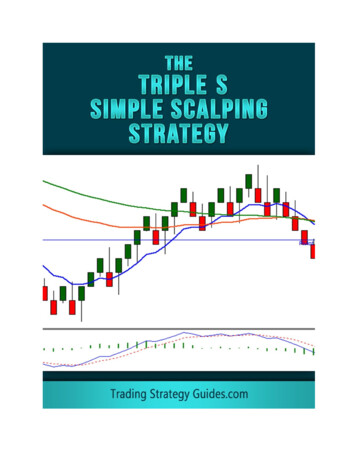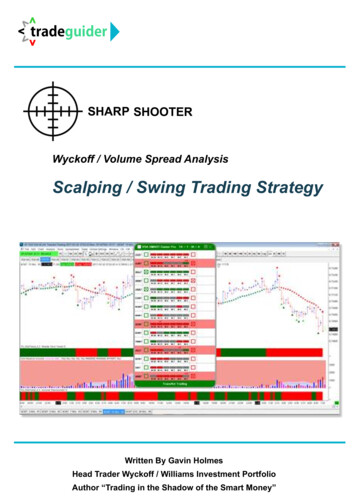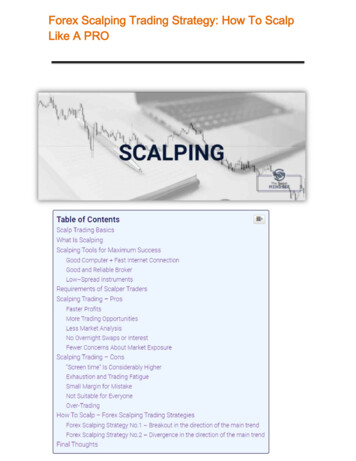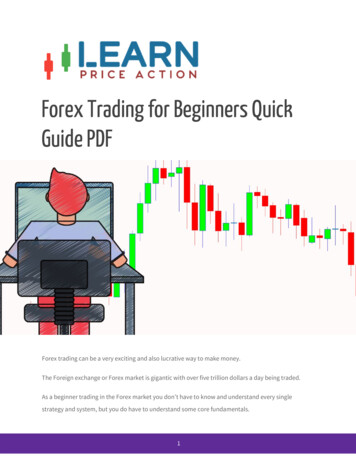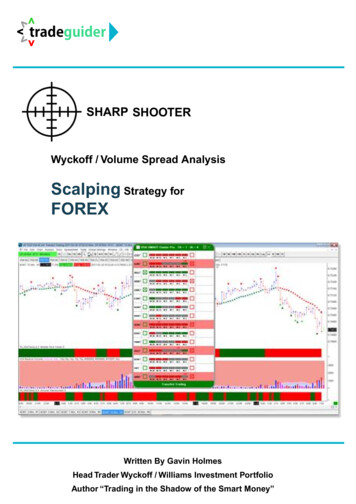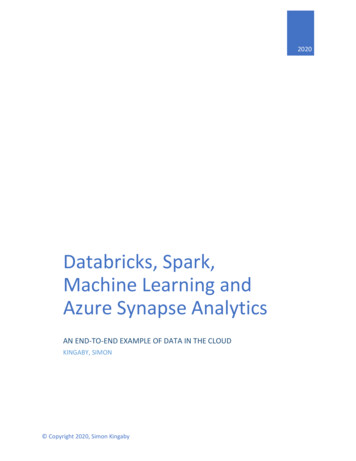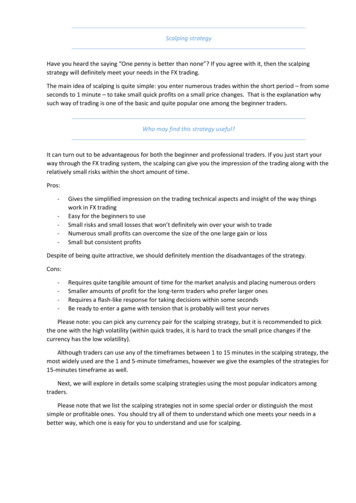
Transcription
Scalping strategyHave you heard the saying “One penny is better than none”? If you agree with it, then the scalpingstrategy will definitely meet your needs in the FX trading.The main idea of scalping is quite simple: you enter numerous trades within the short period – from someseconds to 1 minute – to take small quick profits on a small price changes. That is the explanation whysuch way of trading is one of the basic and quite popular one among the beginner traders.Who may find this strategy useful?It can turn out to be advantageous for both the beginner and professional traders. If you just start yourway through the FX trading system, the scalping can give you the impression of the trading along with therelatively small risks within the short amount of time.Pros:-Gives the simplified impression on the trading technical aspects and insight of the way thingswork in FX tradingEasy for the beginners to useSmall risks and small losses that won’t definitely win over your wish to tradeNumerous small profits can overcome the size of the one large gain or lossSmall but consistent profitsDespite of being quite attractive, we should definitely mention the disadvantages of the strategy.Cons:-Requires quite tangible amount of time for the market analysis and placing numerous ordersSmaller amounts of profit for the long-term traders who prefer larger onesRequires a flash-like response for taking decisions within some secondsBe ready to enter a game with tension that is probably will test your nervesPlease note: you can pick any currency pair for the scalping strategy, but it is recommended to pickthe one with the high volatility (within quick trades, it is hard to track the small price changes if thecurrency has the low volatility).Although traders can use any of the timeframes between 1 to 15 minutes in the scalping strategy, themost widely used are the 1 and 5-minute timeframes, however we give the examples of the strategies for15-minutes timeframe as well.Next, we will explore in details some scalping strategies using the most popular indicators amongtraders.Please note that we list the scalping strategies not in some special order or distinguish the mostsimple or profitable ones. You should try all of them to understand which one meets your needs in abetter way, which one is easy for you to understand and use for scalping.
Useful tipsMaybe you can find this information useful to make your scalping strategies more effective:--Although Stop Loss and Stop Profit set ups are important for any kind of trader, you should knowthat for scalping traders they are essential. In order to make sure your small gains will not causebigger losses, it is highly recommended to establish Stop-loss and Stop-Profit for every order.Stay ready to exit the trade if it does not result into profitable one to prevent a larger loss.
Strategy #1. 50 EMA 100 EMA Stochastic Scalping strategy-Currency pair: any currency pairs, but major currency pairs are preferred.Indicators: 50 EMA, 100 EMA, Stochastic Oscillator (5, 3, 3).Time Frame: 1 min.EMAs are widely used indicators to detect e trend, while Stochastic Oscillator provides information aboutthe best moments when you should enter the trades.When do you start the long order (buy)?1.2.3.4.5.6.EMA (50) reaches the point above the second EMA (100), so it indicates that the trend goes up.Price returns to the EMAs.Now we check the Stochastic Oscillator info: it should reach above the 20 level from below.When all these conditions meet, you enter a Buy trade.Stop Loss: 5 pips.Take profit: 10 pips.
When do you start the short order (sell)?1. On contrary from mentioned above, EMA (50) reaches below the EMA (100), so it indicates thattrend goes down.2. Price returns to the EMAs.3. In this case, the Stochastic Oscillator should cross over the 80 level from above.4. The moment these three conditions meet, you open a Sell trade.5. Stop Loss: 5 pips.6. Take profit: 10 pips.
Strategy #2. SMA Stochastic Scalping strategy - 2-Currency pair: major currency pairs.Indicators: SMA (100 period simple moving average), Stochastic Oscillator (5, 3, 3).Time Frame : 1 minWe use the 100 period simple moving average to determine the trend (the price rises above the averageif the trend goes up; the price falls below the average if the trend goes down) and a Stochastic Oscillatorto identify where to enter the trade.When do you start the long order (buy)?-If the trend goes up and price reaches above the 100 SMA, find the significant levels of supportand draw the horizontal line.The price bounces back to support line.Stochastic oscillator goes below the level 20 and back above 20.Open a buy trade on the close of the candlestick that forms when all the conditions are met.Set Stop Loss 1 pip below the Support level.Take Profit should be at least 20 pips or more.
When do you start the short order (sell)?-If trend goes down and price trades below the 100 SMA, find significant levels of resistance anddraw horizontal line.The price bounces back to resistance line.Stochastic oscillator goes above 80 level and back below the 80.Open a sell trade on the close of the candlestick that forms when all the conditions are met.Set Stop Loss 1 pip above the Resistance level.Take Profit should be at least 20 pips or more.
Strategy #3. Bollinger Bands RSI Stochastic scalping strategy-Currency pair: major currency pairs.Indicators: Bollinger Bands (20, 2. SMA) and RSI (14), Stochastic Oscillator (5, 3, 3).Time Frame: 5 min.Bollinger Bands is a great tool to examine the volatility of the currency pairs. This indicator consists of3 bands, which form the oversold, overbought levels and a middle band as a base. In short, it can beread as following: when the price reaches the upper band, we should be ready to sell and on contrarywhen the price touches the lower band, we should be ready to buy.We use additionally RSI and Stochastic Oscillator to find the enter moments.When do you start the long order (buy)?1.2.3.4.5.6.7.The price goes below the Lower Bollinger BandRSI reaches below 30 levelStochastic Oscillator reaches below 20 levelEnter the buy trade on the close of the candle where all these 3 conditions meetExit the trade when the first candlestick closes above the Middle band.Stop Loss: 10 pips below the lowest value of the piercing candlestickTake profit: 20 pips.
When do you start the short order (sell)?1.2.3.4.5.6.7.The price goes above the upper Bollinger BandRSI reaches above the 70 levelStochastic Oscillator reaches above 80 levelOpen a Sell trade on the close of the candle where all these 3 conditions meetExit the trade when the first candlestick closes beneath the Middle bandStop Loss: 10 pips above the highest value of the piercing candlestick.Take profit: 20 pips.
Strategy #4. Bollinger bands Stochastic 200 EMA scalping strategy-Currency pair: major currency pairs preferable.Indicators: Bollinger Bands (20, 0, 2) and Stochastic Oscillator (5, 3, 3), Moving Average (200).Time Frame: 5 to 15 min.As we examined these indicators in the strategy mentioned above, it should be easier to workthrough this scalping strategy.When do you start the long order (buy)?1.2.3.4.5.The price is above the 200 Moving Average.The Stochastic Oscillator must reach above the Overbought level 80.Wait for the candle to close outside Bollinger Bands on the Upper Band.Stop Loss: adjust the number, so Stop Loss should be below 200 MA.Take Profit: 12 pips.
When do you start the short order (sell)?1.2.3.4.5.The price is below the 200 Moving Average.The Stochastic Oscillator must reach below the Oversold level 20.Wait for the candle to close outside Bollinger Bands on the Lower Band.Stop Loss: adjust the number, so Stop Loss should be over 200 MA.Take Profit: 12 pips.
Strategy #5. 200 period SMA and SSD scalping strategy-Currency pair: major currency pairs.Indicators: SMA (200), Stochastic (5,3,3).Time Frame: 5 minSMA (Simple Moving Average) is one of the most used instruments to spot the trend and its direction.You should check either price is above or below the average, so accordingly the trend tends to rise or tofade. If the price is above the SMA, we assume the trend is up and getting ready to buy. On contrary, ifthe price goes below the SMA, the trend tend to go down and traders should get ready to sell.Next, we check the information from the Stochastic indicator to point the entry moments.When do you start the long order (buy)?1. The price lays above 200 SMA, providing the signals the trend goes up.2. Stochastic crosses the 20 oversold level.3. Once we meet these two conditions, we enter the buy trade on the close of the candlestick thatforms at crossover of the lines of SMA and Stochastic.4. Stop Loss: 10 pips.5. Take Profit: 15 pips.
When do you start the short order (sell)?1. The price lays below the 200 SMA, providing the signals the trend goes down.2. Stochastic crosses the 80 overbought level.3. Once we meet these two conditions, we enter the sell trade on the close of the candlestick thatforms at cross over of the lines of SMA and Stochastic.4. Stop Loss: 10 pips.5. Stop Profit: 15 pips.
Strategy #6. 5 EMA High and Low RSI scalping strategy-Currency pair: any, major currency pairs are preferable.Indicators: 5 EMA, RSI - Relative Strength Index (9).Time frame: 5 minutes.The pattern of this strategy is quite simple: set the 5 EMA High and Low indicators to the chart. Inaddition, we will use RSI indicator to receive more accurate trade entries signals.When do you start the long order (buy)?1. Wait for the candle to open BELOW the 5 EMA Low.2. Now check the RSI for the entry moment: it should go below the 30, so it indicates the bestmoment to enter the long trade.3. Enter the Buy trade at the close of the candle where two conditions met.4. Stop Loss: 8 pips.5. Take Profit: 5 pips.
When do you start the short order (sell)?1. Wait for the candle to open ABOVE the 5 EMA High.6. Now check the RSI for the entry moment: it should go above the 70 level, so it indicates the bestmoment to enter the short trade.2. Enter the Sell Trade at the close of the candlestick where two conditions met.7. Stop Loss: 8 pips.8. Take Profit: 5 pips.
Strategy #7. Ichimoku scalping strategy-Currency pair: any, major currency pairs with high liquidity (like EURJPY, USDJPY, GPBUSD,EURUSD) are preferable.Indicators: Ichimoku kinko hyo (72-144-288)Time frame: 1-5 minutes (can be used on longer timeframes as well)We use Ichimoku (the full name is Ichimoku Kinko Hyo) is a complex of tools generated by Japaneseexperts to identify when the trend starts and ends.The Ichimoku indicator consists of several tools:--the Senkou span is a cloud which is formed by Span line A and Span line B;the Kijun-sen line – is a blue line, more sufficient indicator of the trend. If the price reaches abovethe line, then further growth is expected, if the price goes under the line the coming fall isexpected.Tenkan-sen line – is a red line, it is usually used as a trend pointer.Chikou line – is a line of the most recent price action, plotted 26 trading periods in the past.The Span location can be interpreted to spot the direction of the trend: if the price level is above thecloud, then the trend tends to go up, if the price level is under the cloud then the trend tends to go down.If the price is inside the span, then the market is ranging or flat.If the span line A passes over the span line B (it usually comes along with the color change of the cloud) itprovides a signal of the trend turning upside down in the future period.
Out of all Ichimoku tools, we will use Kumo Cloud and Kijun Sen indicators within this strategy to spot thetrend and identify it.Kumo Span: The position of the price above or under the Kumo cloud provides signals about thedowntrend (when the price is under the cloud) and the uptrend (when the price is above the cloud).Note: when price is inside the cloud do not trade.Kijun Sen: we use this as another indicator of the trend, so we should check it moves either upwards forthe uptrend or downwards for the downtrend.Although Ichimoku itself is a complex tool, we will use the 21 Exponential Moving Average (21 EMA) andRSI Indicator within this scalping strategy.EMA is used to show the direction of the trend, so we are going to examine the slopes of the EMA todetect either trend is strong or not.If 21 EMA shows a good slope, then it is definitely a good sign of the strong trend. On contrast, if the EMAis flat, then do not trade until it provides strong signals with a good slope upward or downward.We will use the RSI signals to define the entry moment: once the RSI bounces the 50 level up or down,we assume it is a signal about an uptrend or downtrend.Moreover, we are going to use Fractals (B.Williams) to indicate where the Stop Loss points should beplaced. When trading long, we will place Stop Loss at the closest red fractal, and when trading short wewill place Stop Loss at the closest green fractal.
When do you start the long order (buy)?How do we identify the trend goes up:1.2.3.4.5.6.Price level is above the Senkou cloud.Price level is over the 21 EMA, its slopes move upwards and well as Kiju Sen.RSI bounces the 50 level and goes up again, when it goes back up then a signal candle appears.Enter the long trade at the low of the signal candle.Stop Loss: at the closest red fractal.Take Profit: 10 pips or more.
When do you start the short order (sell)?How do we identify the trend goes down:Price level is under the Senkou cloud.Price level is underthe 21 EMA, its slopes move downwards and well as Kiju Sen.RSI bounces the 50 level and goes down again, when it goes back down then a signal candleappears.4. Enter the short trade at the high of the signal candle.5. Stop Loss: at the closest green fractal.6. Take Profit: 10 pips or more.1.2.3.
Strategy #8. Heiken Ashi Scalping strategyAlongside with the ability of the Ichimoku tools to detect a trend, the Heiken Ashi charts also give a goodimpression of the trend direction and often used to predict the trend in advance.-Currency pair: any, major currency are preferable.Indicators: Heiken Ashi candles, EMA (20, 50 period)Time frame: 1-5, 15 minutes.Please, note: you can set the color of the Heiken Ashi candles in the Indicator setting. In the examplelisted below red Heiken Ashi candles indicate the uptrend, while blue Heiken Ashi candles indicate thedowntrend.How to identify the trend goes UP: Red candlesticks with long bodies Red candlesticks with no higher shadows provide strong signals about the uptrend.How to identify the trend goes DOWN: Blue candlesticks with long bodies Blue candlesticks with no lower shadows provide strong signals about the downtrend.One candle with small body surrounded with upper and lower shadows will provide the signal that thetrend might change, so probably you should better wait for more sufficient signals.When do you start the long order (buy)?1.2.3.4.5.The 20 EMA reaches above the 50 EMAPrice closes above the 20 EMAOpen a buy trade at the next closed candlestickStop Loss: 10 pips.Take profit: 12 pips.
When do you start the short order (sell)?1.2.3.4.5.The 50 EMA reaches above the 20 EMAPrice closes under the 20 EMAOpen a sell trade at the next closed candlestickStop Loss: 10 pips.Take profit: 12 pips.
Strategy #9. Heiken Ashi Scalping strategy-2-Currency pair: any, major currency are preferable.Indicators: Heiken Ashi candles, SMA (144 period)Time frame: 5 minutes.The rules when to open the buy\sell trades in this strategy are quite simple. You can read about theHeiken Ashi candles above, so you can identify the trend directions with their help easily.Please, note: you can set the color of the Heiken Ashi candles in the Indicator setting. In the examplelisted below red Heiken Ashi candles indicate the uptrend, while blue heiken Ashi candles indicate thedowntrend.When do you start the long order (buy)?1. The Red Heiken Ashi candlesticks form an up-trend, moving over the 114 SMA (SimpleMoving Average).2. The Red Heiken Ashi candlestick closes above the SMA.3. Open the buy trade at close of the candlestick that crossed the SMA line.4. Close the trade when the signals to sell are detected.5. Stop Loss: 10 pips.6. Take Profit: 12 pips.
When do you start the short order (sell)?1. The Blue Heiken Ashi candlesticks form a down-trend, moving under the 114 SMA (SimpleMoving Average).2. The Blue Heiken Ashi candlestick closes below the SMA.3. Open the sell trade at the close of the candlestick that crossed the SMA line.4. Close the trade when the signals to buy are detected.5. Stop Loss: 10 pips.6. Take Profit: 12 pips.
Strategy #10. ADX RSI Scalping strategy-Currency pair: any, major currency pairs are preferable.Indicators: ADX - Average Directional Movement Index (20), RSI - Relative Strength Index (7).Time frame: 5-15 minutes.Average Directional Movement is a tool to detect where the trend flows. However, being used as the onlyindicator it does not give us the chance to spot the moment where to enter the trade. For this reason, weuse it alongside with the RSI – Relative strength index, to check where we can enter the trades.ADX consists of 3 lines: ADX itself to represent the strength of the trend, the DI to represent to growth ofthe price and finally the –DI to show when the price declines. To describe it in a simple way: a buy signaloccurs when DI moves above -DI and a sell signal when DI moves below the DI.When do you start the long order (buy)?1.2.3.4.Check the DI goes above the –DI, this will provide the signal of the price tend to growADX shouldn’t fall below the 20 (which shows the strong trend)RSI raises above 70Enter the buy trade at the close of the candlestick that forms at the crossover of the linesmentioned above5. You can hold the buy position until the RSI goes beyond the 70.6. Stop Loss: 10 pip7. Take Profit: 15 pips.
When do you start the short order (sell)?1.2.3.4.5.6.7.Check the –DI goes above the DI as a sign of a downtrendADX shouldn’t fall below the 20 (which shows the strong trend)RSI falls below the 70Enter the sell trade at the close of the candlestick that forms at the crossover of the linesmentioned aboveYou can hold the sell position until the RSI goes above the 70Stop Loss: 10 pips.Take profit: 15 pips.
Strategy #11. MACD and Stochastic Scalping Strategy- Currency pair: any, major currency are preferable.- Indicators: MACD (13, 26,9), Stochastic (5, 3, 3)- Time frame: 1-5, 15 minutes.MACD is the abbreviation for the Moving Average Convergence Divergence. It contains 3 elements: 2moving averages and a histogram. The histogram represents the variation between the two averages. Theposition of the histogram according the zero level helps to detect the direction of the trend: if the histogram level is above the zero level, then the price is forming an uptrend.if the histogram level is below the zero level, then the price is forming a downtrend.In this type of the strategy, we will use Stochastic Oscillator as the additional tool to detect the mostprecise moment to enter the trade. We set it with 80 and 20 levels, which will form the overbought (80)and oversold (20) areas.When do you start the long order (buy)?1. We should check the histogram hillsides to raise above the zero level, come nearly to thezero level and then to increase again.2. Now as we have the proof of an uptrend, we seek for an extra confirmation from thestochastic indicator lines. One of its line should cross the oversold area or two of themshould cross down the level of 20.3. We point out the candlestick that caused the two conditions above and the time it isclosed, we enter the Buy trade.4. Stop Loss: 10 pips.5. Take profit: 15 pips.
When do you start the short order (sell)?1. This time we should check the histogram hillsides to go below the zero level, come nearlyto the zero level and then to decline again.2. Now as we have the proof of a downtrend, we seek for an extra confirmation from thestochastic indicator lines. One of its line should cross the oversold area or two of themshould cross above the level of 80.3. We point out the candlestick that caused the two conditions above and the time it isclosed, we enter the short trade.4. Stop Loss: 10 pips.5. Take profit: 15 pips.
Strategy #12. 2 MACD Scalping strategy-Currency pair: any, major currency are preferable.Indicators: MACD (36, 75, 30), MACD (12, 26,9)Time frame: 5 minutes.We use the Slow period MACD to spot the direction of the trend, so the default period MACD willpoint out the entry of the trade.When do you start the long order (buy)?1. The slopes of the Slow MACD histogram(36, 75,30) are above the zero level.2. Next, we check the histogram of the Default MACD (12, 26, 9). At least one bar appearsabove the zero level after first bar appears and closes below the zero level. This should beour entry sign, so we enter the buy trade on candle close.3. Stop Loss: 12 pips.4. Take Profit: 20 pips.
When do you start the short order (sell)?1. The slopes of the Slow MACD histogram are below the zero level.2. First, we detect at least one bar opening and closing above the zero level at the DefaultMACD, after the first bar under the zero level we open a trade to sell.3. Stop Loss: 12 pips.4. Take Profit: 20 pips.
Strategy #13. Awesome Stochastic Bollinger Bands 3 EMA-Currency pair: any, major currency pairs are preferable, because this strategy works good onvolatile market only.Indicators: Awesome Stochastic, Bollinger Bands (20, 2), EMA (3 period).Time frame: 1; 5 minutes.When do you start the long order (buy)?1.2.3.4.5.SMA (Simple Moving Average) trades above the Middle Bollinger Band.Awesome Stochastic turns green and is above the zero level.Enter the buy trade when 2 conditions are met.Stop Loss: set below the most recent support line.Take Profit: suggested Stop Loss x2.
When do you start the short order (sell)?1.2.3.4.5.SMA (Simple Moving Average) trades below the Middle Bollinger Band.Awesome Stochastic turns red and is below the zero level.Enter the sell trade when 2 conditions are met.Stop Loss: set above the most recent resistance level.Take Profit: suggested Stop Loss x2.
Strategy #14. Bollinger Bands RSI scalping strategy-Currency pair: any, major currency pairs preferable.Indicators: Bollinger Bands (20, 2), RSI (9 period).Time frame: 5 minutes.When do you start the long order (buy)?1.2.3.4.5.The price level touches the Lower Band and bounces back.RSI is in Oversold zone below 30 level.Enter the buy trade on the candlestick, when two conditions are met.Stop Loss: 10 pips.Take Profit: 5 pips.
When do you start the short order (sell)?1.2.3.4.5.The price level touches the Upper Band and bounces back.RSI is in the Overbought zone above 70 level.Enter the sell trade on the candlestick, when two conditions are met.Stop Loss: 10 pips.Take Profit: 5 pips.
Strategy #15. RSI Awesome Oscillator-Currency pair: any, major currency pairs preferable.Indicators: RSI (9), Awesome Oscillator (default settings).Time frame: 30 minutes.When do you start the long order (buy)?1. RSI reaches over 30 level from below.2. Check the Awesome Oscillator for the green bar to appear. Once it appears, we are readyto open a buy trade at close of the candlestick.3. Stop Loss: should be set under the swing.4. Take Profit: 10 pips.
When do you start the short order (sell)?1. The RSI crosses the 70 level from above and begin to fall.2. Check the Awesome Oscillator for the red bar to appear. Once it appears, enter the buytrade at the close of the candlestick.3. Stop Loss: above the swing high.4. Take Profit: 10 pips.
Strategy #4. Bollinger bands Stochastic 200 EMA scalping strategy - preferableCurrency pair: major currency pairs . - Indicators: Bollinger Bands (20, 0, 2) and Stochastic Oscillator (5, 3, 3), Moving Average (200). - Time Frame: 5 to 15 min. As we examined these indicators in the strat
